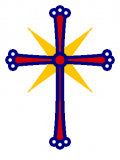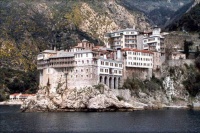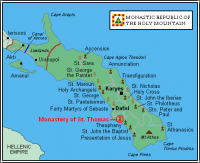Monastery of St. Thomas
| Part of the series on Church of the East |

|
| Association |
| Communion of the Church of the East |
| Member Churches |
| Assyrian Church Borneian Church Religion of Light Chaldean Syrian Church Church of the East in Arakan, Burma and Tenasserim |
| Topics |
| Catholicos Assyrian Monasticism Assyrian Hospitals School of Samarqand Monastery of Mar Toma |
| People |

| |
| Church: | Assyrian |
| Number of Monks: | 25 |
| Location: | Mount Athos, Monastic Republic |

| |
| Date of Foundation: | 1994 |
| Hegumen: | Mar Khoch Zaya |
| Service Focus: | Ecumenical outreach Medical ministry Theological study |
Introduction
The Monastery of Mar Toma, known to its Athonite neighbours as Άγιος Τωμάς, or St. Thomas, is the newest monastic community of the Holy Apostolic Catholic Assyrian Church of the East. Despite its small size and (for Assyrians) odd location, the Monastery of Mar Toma is fast gaining a significance for the Assyrian Church out of all proportion to its numbers.
History
Founding of the Assyrian Monastery
The Monastery of Mar Toma was not always an Assyrian monastery. Up until 1994, there were no representatives of any of the Churches of the East in the Serene Monastic Republic of the Holy Mountain and the buildings which are now the Mar Toma monastery stood empty. Planting a new monastic community in a previously unreached area is nothing new for the Assyrian Church; however, this was somewhat different.
It began in 1994, when Archimandrite Gregory of Annunciation, the spiritual leader of the Autonomous Orthodox Church of the Holy Mountain extended an invitation to the new Catholicos of the Assyrian Church of the East, Mar Abdiyeshu XVII, to send some Assyrian monks to inhabit the long-deserted Monastery of the Nativity on Mount Athos, joining the several Eastern Orthodox monastic communities and the Cambrian and Maronite Catholic communities in an ongoing ecumenical experiment.
Mar Abdiyeshu was, and is, committed to opening ecumenical dialogue with other Christian churches, wishing to use such dialogue both to broaden and deepen the understanding of his own Church in its unique role within the wider Body of Christ, and also to raise the level of awareness and knowledge of Eastern Christianity among those of other denominations. His inclination was from the first to accept the invitation relayed to him by Mar Gewargis Sabrisho, the Assyrian Metropolitan of Europe in Constantinople. However, due to the structure of the Assyrian Church, he felt it better to raise the issue at the Metropolitan Synod of Xotan the following year.
After some discussion, the assembled metropolitan archbishops of the Church agreed that to accept the invitation would be a Good Thing. The first monks began to arrive at the Monastery of the Nativity towards the end that year, and to begin to undertake enough restoration of the previously uninhabited monastery to make the place liveable. The first permanent monks, under the leadership of the present hegumen, Mar Khoch Zaya, began to arrive in 1995.
History of the Monastery of the Nativity
- 1257 - The Monastery of New Bethlehem is founded, so named by its founder, Bl. Simon the Myrrhobletes.
- 1601 - The katholikon of the Monastery of New Bethlehem is built and dedicated to the Nativity of Jesus and thus gives the monastery its new name.
- 1678 - The Monastery of the Nativity is deserted because of heavy Turkish taxation.
- 1794 - Ioasaph of Mytilene arrives and begins the restoration of the Monastery of the Nativity.
- 1891 - The katholikon of the Monastery of the Nativity is destroyed by fire and rebuilt in its present form.
- 1894 - The Monastery of the Nativity is abandoned.
- 1994 - The Assyrian Church is invited to send monks to occupy the abandoned Monastery of the Nativity, which they rename the Monastery of St. Thomas.
- 1995 - Monks from the St. Thomas monastery take over the running of Christ Healer clinic in Prosforion.
Service
The Monastery of St. Thomas, true to its roots in the Assyrian monastic tradition, is highly involved in several ongoing fields of service to the local community.
The most visible of these is their medical service in operating Christ Healer Clinic in Ammouliàn and associated work with Holy Spirit Hospital in Prosforion. Brother Doctor Shimun heads the medical ministry team; he is the medical chief of staff at Christ Healer Clinic.
Medical ministry is not the monks' only form of service to the community, however. The other main thrust of their service ministry is far less visible: the ongoing restoration of the previously deserted Katholikon of the Nativity on the monastery's grounds. This is done in a spirit of pure service to the other monks of Mount Athos; most of the Assyrians feel the katholikon to be too big for regular use by only 25 monks, and besides, it is overly decorated by Assyrian standards. Brother Abajan is in charge of the ongoing work of restoration.
Demographics
Due to its unique nature as a kind of ecumenical embassy for the Assyrian Church, the Monastery of Mar Toma is particularly diverse in its ethnic makeup. Care has been taken by the Assyrian hierarchy to send some of their best representatives, and this has had the effect of increasing the ethnic diversity rather than lessening it. From their perspective it has been a delicate balancing act trying to balance the felt call of God on the lives of its monks and the pragmatic desire to represent the Church in the best possible light.
Because of the wide geographical and ethnic mix of the monastery, Syriac is used as an internal lingua franca.
The exact demographics are as follows:
| Uygurs | 6 |
| Persians | 5 |
| Qazaqs | 4 |
| Lebanese Arabs | 2 |
| Tajiks | 2 |
| Iraaqi Arabs | 1 |
| Mongolians | 1 |
| Tibetans | 1 |
| Turcomans | 1 |
| Tuvins | 1 |
| Uzbeks | 1 |
The Monks
Hegumen Mar Khoch Zaya
The hegumen of Mar Toma is Mar Khoch Zaya (in Athonite: Μαρ Χοχ Ζάγια), one of four of the monks of Mar Toma who are also priests. At 43 years of age, he is on the young side for a full hegumen, especially the hegumen of a monastery of this high importance. However, Mar Khoch Zaya is one of the Assyrian Church's most prominent upcoming theologians. His assignment to the Monastic Republic can only be considered a compliment to the Athonites and an indication of how valued this particular ecumenical experiment is at the highest levels of the Assyrian Church.
Hegumen Mar Khoch Zaya is the youngest hegumen of the twenty monasteries on the Holy Mountain. He is an ethnic Persian, and was born in the city of Shahrisabz in the Tajikistan province of Turkestan.
Brother Doctor Shimun
Brother Doctor Shimun is an ethnic Uygur, and is the senior of the two full M.D.s among the Mar Toma monks. He is chief of staff of Christ Healer Clinic in Ammouliani, and as such, is de facto head of the main service outreach arm of the monastery. As such, he should be the under-hegumen of the whole monastery, but Brother Doctor Shimun recognises that this is neither his calling nor his area of giftedness. The librarian, Brother Yeshuyab, functions as under-hegumen in Dr. Shimun's place.
Brother Yeshuyab
Brother Yeshuyab is the sole representative on Mount Athos of the once-powerful Tibetan branch of the Assyrian Church. Alas, the Assyrian Church in Tibet today is a small, persecuted minority, but the Communion of the Church of the East has not forgotten that once the Tibetans were known for their abiding faith in the Christ. Brother Yeshuyab (his name means "Given by Jesus") is the chief librarian of Mar Toma, and the under-hegumen of the monastery.
This last more or less means that he is the one called upon to represent the monastery if and when Mar Khoch Zaya is unavailable.
Brother Doctor Yusuf
Brother Doctor Yusuf is one of the two Lebanese Assyrian monks of the monastery, and with Brother Doctor Shimun, the other full M.D.-level physician among the monks. His medical training is more specialised than Brother Doctor Shimun's, but he is the resident expert in endocrinology and hormonally-based therapies, and in such fields, Dr. Shimun defers to him.
Brother Tulmai the Qazaq
Brother Tulmai, called "the Qazaq" to distinguish him from the other Brother Tulmai, a Persian, is the stablemaster of the monastery. He oversees the care of the donkeys used by the monks whenever they have to travel.
In addition to his work with animals, Brother Tulmai is one of the best linguists among the monks, already speaking about 15 languages before he added Athonite and modern Greek to the list.
Brother Timothy
Brother Timothy is in charge of the monastery's gardens. Perhaps surprisingly, he is the only Uzbek among the monks, and is also one of the oldest, at 84. However, he is still quite active and his knowledge of growing things is virtually encyclopaedic, even for Uzbeks, who have a reputation for green fingeredness.
Brother Timothy is possibly the most reluctant of the monks to be on Mount Athos; he was plucked (as he claims) from his beloved gardens in the Monastery of Mart Martha in Andıjan, Uzbekistan, at the personal request of his younger brother, Metropolitan Mar Gevärges of Buxara. He speaks little Greek beyond a few simple phrases, and has a tendency to slip out of Syriac and into Uzbek as the day wears on, but is nonetheless loved and respected by the other monks.
Brother Abajan
Brother Abajan is the main representative of the Discipline of Aaron and Hur, the arm of the Assyrian monastic movement that specialises in "serving the servers". In this case, Brother Abajan is in charge of the ongoing work of restoring the monastery to its former state, particularly the delicate tasks associated with the full restoration of the katholikon.
This is something of a politically delicate task as well, as the katholikon is far more lavishly decorated than the simpler Assyrian churches, and in the Greek Orthodox manner, not the Syriac Assyrian style. The monks have taken to using one of the larger rooms of the monastery itself to hold their own regular worship services in, and do not expect to use the (to them) slightly alien-looking and overlarge katholikon. The restoration is something that they consider an act of worship to God and of service to their fellow monks.
Mar Samsoun
Mar Samsoun is another monk from Lebanon, formerly involved in theological teaching at the large Monastery of Mar Yeshubab in Qojaya. He assists Brother Yeshuyab in maintaining the monasterial library and is often selected to be a part of any formal ecumenical discussion fora. The existence of an Assyrian monastery in the Monastic Republic at all is something of an exercise in ecumenism, but there are also periodic discussions on a more formal basis. Mar Samsoun's background in theological study and teaching makes him a regular participant in these exchanges.